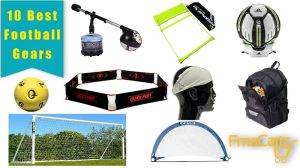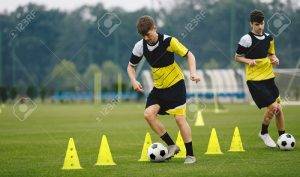Football, a sport synonymous with intensity, strategy, and athleticism, demands a specialized arsenal of equipment to ensure player safety, performance, and adherence to the game’s rules. In this exhaustive exploration, we delve into the intricate world of football equipment, unraveling the purpose, design, and evolution of each piece that adorns the modern gridiron warrior. From the iconic helmet to the cleats that grip the turf, we dissect the gear that forms the backbone of every player’s toolkit, contributing to the dynamic and fiercely competitive nature of the game.
The Essential Football Equipment
Helmet: Safeguarding the Crown
Purpose and Design:
The football helmet is a crucial piece of protective gear designed to shield players from head injuries. It consists of a hard outer shell and a padded interior that absorbs impact forces. The face mask, a grille-like structure, protects the player’s face without compromising visibility.
Evolution:
Over the years, helmet technology has advanced to enhance safety. Modern helmets feature impact-absorbing materials, improved ventilation, and customizable fits to provide optimal protection and comfort.
Shoulder Pads: Armor for the Upper Body
Purpose and Design:
Shoulder pads protect the shoulders, chest, and upper back from impact during tackles and collisions. They consist of hard plastic shells, padding, and adjustable straps to ensure a secure fit.
Evolution:
Advancements in materials have led to lighter yet more durable shoulder pads. Position-specific pads cater to the unique needs of players, providing enhanced protection while allowing for unrestricted movement.
Jersey and Pants: Identity and Performance
Purpose and Design:
The jersey and pants are integral to a player’s identity and serve practical purposes. Jerseys are made from breathable materials, often featuring team colors and logos. Pants are typically made of durable materials with built-in pads for added protection.
Evolution:
Modern jerseys incorporate moisture-wicking fabrics to keep players dry, and pants may include strategic padding to shield vulnerable areas. Customization options allow teams to showcase their unique style.
Cleats: Traction on the Turf
Purpose and Design:
Football cleats are specially designed shoes with studs or spikes on the sole to provide traction on the playing surface. The design varies based on position and playing conditions.
Evolution:
Advancements in cleat technology focus on optimizing grip, stability, and agility. Cleats now come in various styles, including molded, detachable, and turf shoes, catering to different playing surfaces.
Gloves: Enhancing Grip and Control
Purpose and Design:
Football gloves are designed to improve a player’s grip on the ball. They feature tacky surfaces on the palms and fingers, enhancing ball control and catching ability.
Evolution:
The evolution of football gloves has seen the incorporation of advanced materials for improved grip and flexibility. Position-specific gloves address the unique needs of different players, from receivers to linemen.
Mouthguard: Protecting the Pearly Whites
Purpose and Design:
The mouthguard is a crucial piece of protective equipment that reduces the risk of dental injuries. It is typically made of pliable material that molds to the shape of the player’s mouth.
Evolution:
While the basic design remains consistent, advancements include customization options for better fit and comfort. Some mouthguards also offer additional features, such as improved breathability.
Protective Cups: Safeguarding Sensitive Areas
Purpose and Design:
Male players wear protective cups to safeguard the groin area from impact. They are typically made of hard plastic and fit securely inside compression shorts.
Evolution:
Modern cups focus on providing comfort and flexibility without compromising protection. Innovative designs offer increased mobility while ensuring essential coverage.
Position-Specific Equipment
Quarterback Gear: Precision and Protection
Purpose and Design:.
Quarterbacks wear additional protective gear, including rib pads and a flak jacket, to safeguard against hits. Gloves with enhanced grip aid in ball control.
Evolution:
Advancements in materials have led to lighter protective gear for quarterbacks, ensuring minimal interference with throwing mechanics while maximizing safety.
Linemen Equipment: Bulk and Braces
Purpose and Design:
Linemen wear larger and more heavily padded shoulder pads to withstand the physical demands of the position. Knee braces and additional padding offer extra protection.
Evolution:
Incorporation of advanced materials has reduced the overall weight of linemen’s gear while maintaining durability. Customization options cater to individual player preferences.
Receiver Gear: Precision and Flexibility
Purpose and Design:
Receivers prioritize agility and ball control. Their gloves feature advanced grip technology, and they may wear lighter shoulder pads to enhance mobility.
Evolution:
Receiver gloves continue to evolve with improvements in grip and flexibility. Lightweight yet protective shoulder pads offer a balance between mobility and safety.
Kicker/Punter Gear: Streamlined Efficiency
Purpose and Design:
Kickers and punters wear minimal padding to maintain flexibility. Their cleats are designed for precision, and they often use a specialized kicking shoe.
Evolution:
Advancements in kicking shoes focus on improving accuracy and control. Lightweight and flexible padding options ensure protection without hindering performance.
Ensuring Compliance and Safety
Regulatory Standards:
NOCSAE Certification:
The National Operating Committee on Standards for Athletic Equipment (NOCSAE) certifies football helmets and other protective gear to ensure they meet safety standards.
League Compliance:
Football leagues, from youth to professional levels, enforce specific equipment regulations to prioritize player safety and maintain a level playing field.
Player Education:
Proper Fitting:
Ensuring that players wear properly fitted equipment is crucial for both performance and safety. Ill-fitting gear can compromise protection and hinder mobility.
Injury Prevention:
Players are educated on the importance of equipment in injury prevention. This includes understanding the purpose of each piece of gear and maintaining it in good condition.
The Future of Football Equipment
Innovation in Materials:
Smart Fabrics:
The integration of smart fabrics with sensing capabilities could revolutionize football gear, providing real-time data on player performance and health.
Lightweight Protection:
Continued advancements in lightweight yet robust materials may lead to even more streamlined and protective football equipment.
Customization and Personalization:
3D Printing:
3D printing technology could enable the creation of customized gear tailored to an individual player’s body shape and playing style.
Smart Accessories:
Smart accessories, such as helmets with built-in communication devices or augmented reality features, could become standard in football equipment.
Related Post:
Decoding the Plate: Major League Umpire Salaries Unveiled
Deciphering The Sweet Science: How Long Do Boxing Matches Last
Navigating the Soccer Chronicles: The Intricacies of Extra Time in Soccer
In the grand symphony of football, each piece of equipment plays a distinctive role, harmonizing protection, performance, and individual style. From the meticulously engineered helmet to the specialized cleats that dig into the turf, football equipment embodies a fusion of tradition, innovation, and a relentless pursuit of excellence.
As players step onto the gridiron, clad in their technologically advanced armor, they not only carry the weight of a team but also the legacy of the sport itself. Football equipment, in its ever-evolving state, stands as a testament to the commitment of players, coaches, and manufacturers to push the boundaries of safety and performance on the hallowed grounds of the football field.



